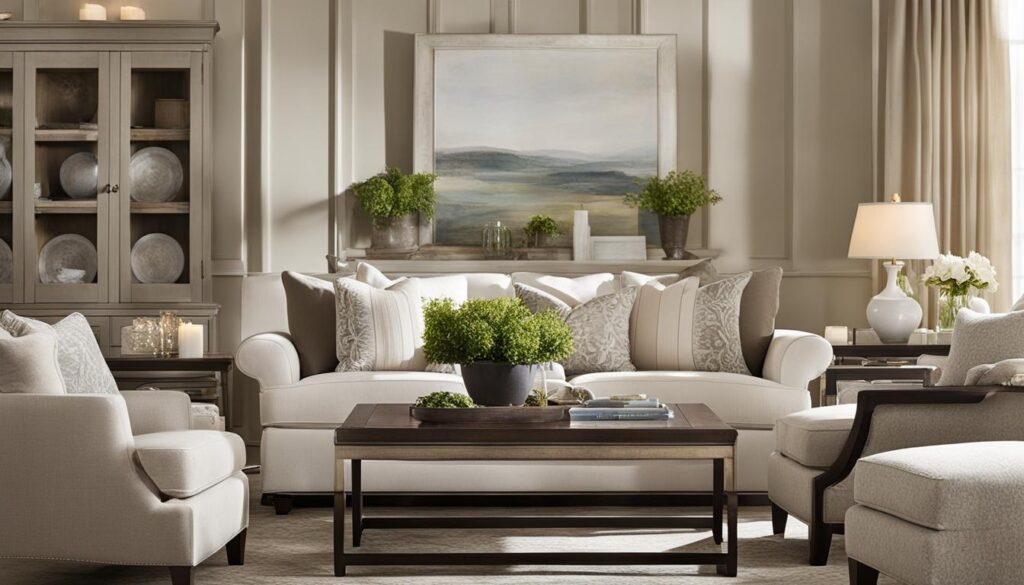Staging a living room is a crucial step in preparing your home for sale. By presenting your living room in the best possible light, you can attract potential buyers and increase the likelihood of a successful sale. To stage your living room effectively, follow these expert tips:
Table of Contents
Key Takeaways:
- Utilize strategic furniture placement to create an inviting and functional layout.
- Focus on decluttering and creating a clean, tidy environment.
- Enhance natural light by opening curtains or blinds and adding mirrors.
- Use neutral colors and décor to create a neutral and appealing atmosphere.
- Consider hiring a professional stager for expert advice and assistance.
The Importance of Staging a Living Room for Selling Your Home
Staging your living room before selling your home is crucial for several reasons. First, it helps potential buyers envision themselves living in the space by creating a neutral and inviting atmosphere. Second, staging can increase the listing price, decrease the time on the market, and increase the chances of selling over the asking price. To ensure an effective staging process, consider the following tips:
1. Declutter and Depersonalize
Start by removing personal items such as family photos and excessive decor. This allows buyers to imagine their own belongings in the space and helps create a blank canvas for them to envision their future home. Additionally, decluttering your living room will make it appear more spacious and organized, enhancing its overall appeal.
2. Create a Neutral Palette
When staging your living room, opt for neutral colors on the walls, furniture, and decor. Neutral tones create a calming and inviting atmosphere, appealing to a broader range of potential buyers. It also allows them to easily visualize how their own furniture and belongings would fit into the space.
3. Focus on Furniture Placement and Layout
Arrange your furniture in a way that highlights the room’s features and maximizes its flow. Avoid blocking windows, doorways, or any architectural elements. Create conversational areas by arranging furniture in a way that encourages social interaction. Additionally, remove any bulky or unnecessary furniture to make the room appear more spacious.
4. Let There Be Light
Maximize natural light by opening curtains or blinds during showings. Well-lit spaces feel more inviting and spacious. If the living room lacks natural light, strategically place lamps or other light sources to brighten the space. Layering different light sources can create a warm and cozy ambiance.
By following these effective strategies for staging your living room, you can create a space that captures the attention of potential buyers and increases the likelihood of a successful sale.
| Benefits of Staging a Living Room | How it Helps |
|---|---|
| Enhances visual appeal | Creates a neutral and inviting atmosphere |
| Influences buyer’s perception | Allows potential buyers to envision themselves living in the space |
| Increases listing price | Can lead to higher offers and selling over the asking price |
| Reduces time on the market | Attracts more buyers and speeds up the selling process |
Conclusion
Successfully staging a living room is crucial when preparing your home for sale. By implementing these best practices for staging a living room, you can create an enticing and appealing space that will capture the attention of potential buyers.
Start by decluttering and deep cleaning the room to create a fresh and inviting atmosphere. Remove personal items and excess furniture to allow buyers to envision themselves living in the space. Additionally, consider rearranging the furniture to maximize the room’s flow and highlight its best features.
When it comes to décor, opt for neutral colors and minimal accessories to create a blank canvas for buyers to project their own style onto. Incorporate natural light by opening curtains or blinds and strategically placing mirrors to create a sense of brightness and spaciousness.
Remember to maintain a cohesive and visually pleasing layout throughout the living room. Pay attention to details such as artwork placement, rug positioning, and overall balance. If you need assistance, don’t hesitate to consult a professional stager who can provide expert advice and guidance.
By following these successful living room staging ideas and best practices, you’ll be setting the stage for a successful home sale. Don’t forget to extend your staging efforts to other areas of your home as well, as a cohesive and well-staged overall appearance can greatly enhance the appeal of your property.
FAQ
Why is staging a living room important when selling a home?
Staging a living room is important because it helps potential buyers envision themselves living in the space by creating a neutral and inviting atmosphere. It can also increase the listing price, decrease the time on the market, and increase the chances of selling over the asking price.
What are some tips for effectively staging a living room?
Some tips for effectively staging a living room include decluttering and deep cleaning, strategically placing furniture, using neutral decor, playing up the room’s best features, highlighting natural light, and creating a cohesive and visually pleasing layout.
Should I consider hiring a professional stager?
It is worth considering hiring a professional stager if needed. They have expertise in creating appealing and inviting spaces that will attract potential buyers and increase the chances of a successful sale.
Should I extend the staging efforts to other areas of my home?
Yes, it is recommended to extend the staging efforts to other areas of your home. Creating a cohesive and well-staged environment throughout the entire house can make a positive impression on potential buyers and increase the overall appeal of your property.


